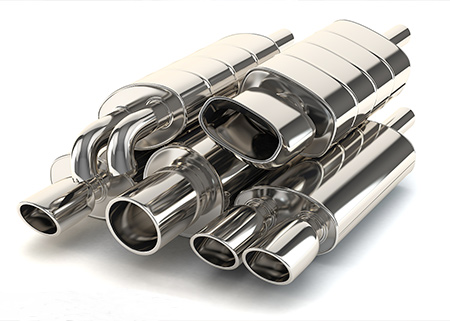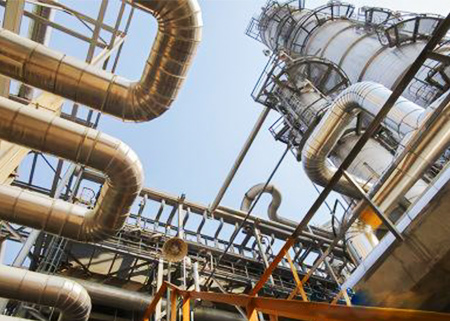Introduction
Exhaust systems play a crucial role in various industries, including industrial and automotive sectors. They not only efficiently expel exhaust gases and heat but also protect the environment and enhance equipment performance. Stainless steel pipes, as a high-quality material, possess numerous unique characteristics and advantages, making their application in exhaust systems increasingly significant.

Common Choices of Stainless Steel Pipes in Exhaust Systems
Automotive Exhaust Systems
Stainless steel pipes find extensive use in automotive exhaust systems. Their outstanding heat resistance and corrosion resistance enable them to withstand high-temperature exhaust gas flows, effectively reducing corrosion and damage to exhaust systems, thus extending the lifespan of automobiles.
Industrial Exhaust Systems
Many industrial sectors require the discharge of exhaust gases, such as power plants, chemical plants, and steel mills, among others. Stainless steel pipes are widely utilized in these exhaust systems because they can endure high temperatures and corrosive gases, providing long-term durability. This makes industrial exhaust systems more reliable and reduces the frequency of pipeline maintenance and replacement.
Building Exhaust Systems
Exhaust systems in commercial and residential buildings are used to expel waste gases generated in spaces like kitchens and bathrooms. Stainless steel pipes are extensively employed in these exhaust systems due to their ability to withstand high temperatures and humidity, along with exceptional corrosion resistance, ensuring indoor air quality and the longevity of structures.
Medical Facility Exhaust Systems
Medical facilities such as hospitals and laboratories need to expel various harmful gases and exhaust. Stainless steel pipes are widely used in these exhaust systems because they can withstand high temperatures, corrosive gases, are easy to clean and maintain, contributing to the safety of medical environments.
Environmental Facilities Exhaust Systems
Environmental facilities like sewage treatment plants and waste incineration plants require the expulsion of exhaust gases and harmful substances. Stainless steel pipes are extensively applied in these exhaust systems as they can endure high temperatures and corrosive gases, being environmentally friendly and contributing to environmental health and sustainability.
Corrosion Resistance and 316L
The corrosion resistance of stainless steel pipes is their key ability to resist corrosion under various environmental conditions. Typically, stainless steel pipes are made from steel with alloying elements such as chromium, nickel, and molybdenum, which can form a dense oxide film, effectively inhibiting the corrosion of the metal surface.
316L stainless steel, as a low-carbon version of 316 stainless steel, possesses superior corrosion resistance. Especially in acidic exhaust environments, such as in chemical plant exhaust treatment systems, 316L stainless steel exhibits outstanding corrosion resistance.
Chemical Composition of 316L Stainless Steel
| Element | Carbon (C) | Silicon (Si) | Manganese (Mn) | Phosphorus (P) | Sulfur (S) | Chromium (Cr) | Nickel (Ni) | Molybdenum (Mo) | Iron (Fe) |
| Content (%) | ≤ 0.03% | ≤ 0.75% | ≤ 2.00% | ≤ 0.045% | ≤ 0.030% | 16.0 – 18.0% | 10.0 – 14.0% | 2.0 – 3.0% | Remaining |
316L stainless steel, due to its excellent corrosion resistance, can resist the corrosion caused by substances such as sulfuric acid and hydrochloric acid, significantly prolonging the service life of pipeline systems.
High-Temperature Resistance and 316L
316L stainless steel exhibits excellent resistance to high temperatures.
Maximum Operating Temperature
The maximum operating temperature of 316L stainless steel is typically around 870°C (1600°F). Within this temperature range, 316L stainless steel can maintain its mechanical performance and corrosion resistance.
Coefficient of Thermal Expansion
The coefficient of thermal expansion of 316L stainless steel is 16.5 x 10^-6/°C (9.2 x 10^-6/°F). This means that at high temperatures, the dimensions of 316L stainless steel will expand slightly with increasing temperature.
National Standard
In China, the national standard for 316L stainless steel is GB/T 20878-2007 “Chemical Composition and Mechanical Properties of Stainless and Heat-Resisting Steels.” This standard specifies the chemical composition, mechanical properties, and other relevant requirements of 316L stainless steel.
High-Temperature Applications
316L stainless steel finds extensive use in high-temperature industrial sectors, including petrochemicals, power generation, refining, fertilizers, and heat treatment.
Corrosion and Oxidation Resistance
Stainless steel pipes are highly favored due to their exceptional corrosion and oxidation resistance.
Crucial Role of Chromium
The chromium element in stainless steel is crucial for its corrosion and oxidation resistance. Chromium combines with oxygen to form a dense chromium oxide layer (Cr2O3), known as a passivation layer, on the surface of stainless steel. This passivation layer effectively prevents the corrosion and oxidation of stainless steel, protecting the pipeline from harm.
Enhancing Role of Nickel
Nickel in stainless steel also plays a significant role in enhancing corrosion resistance and oxidation resistance. Nickel enhances the passivation ability of chromium, improving the corrosion resistance of stainless steel.
Enhancing Role of Molybdenum
Some stainless steels contain molybdenum to further enhance their corrosion and oxidation resistance.
Practical Applications with 316L
Petroleum Refinery Exhaust Systems

In petroleum refineries, high-temperature industrial exhaust gases often contain significant amounts of steam, acidic gases, and corrosive substances. The use of 316L stainless steel pipes ensures corrosion resistance and high-temperature performance of the system.
Heat Treatment Industry Exhaust Systems
In the heat treatment industry, high-temperature exhaust gases contain substantial hot gases and corrosive substances. The use of 316L stainless steel pipes ensures high-temperature resistance and corrosion resistance of the system.
Power Plant Exhaust Systems
In power plants, high-temperature exhaust gases contain a significant amount of flue gas, steam, and acidic gases. The use of 316L stainless steel pipes ensures high-temperature resistance and corrosion resistance of the system.
Conclusion
Stainless steel pipes indeed offer numerous significant benefits in exhaust systems. They play a critical role in system sustainability, environmental friendliness, reliability improvement, and the reduction of maintenance costs.
